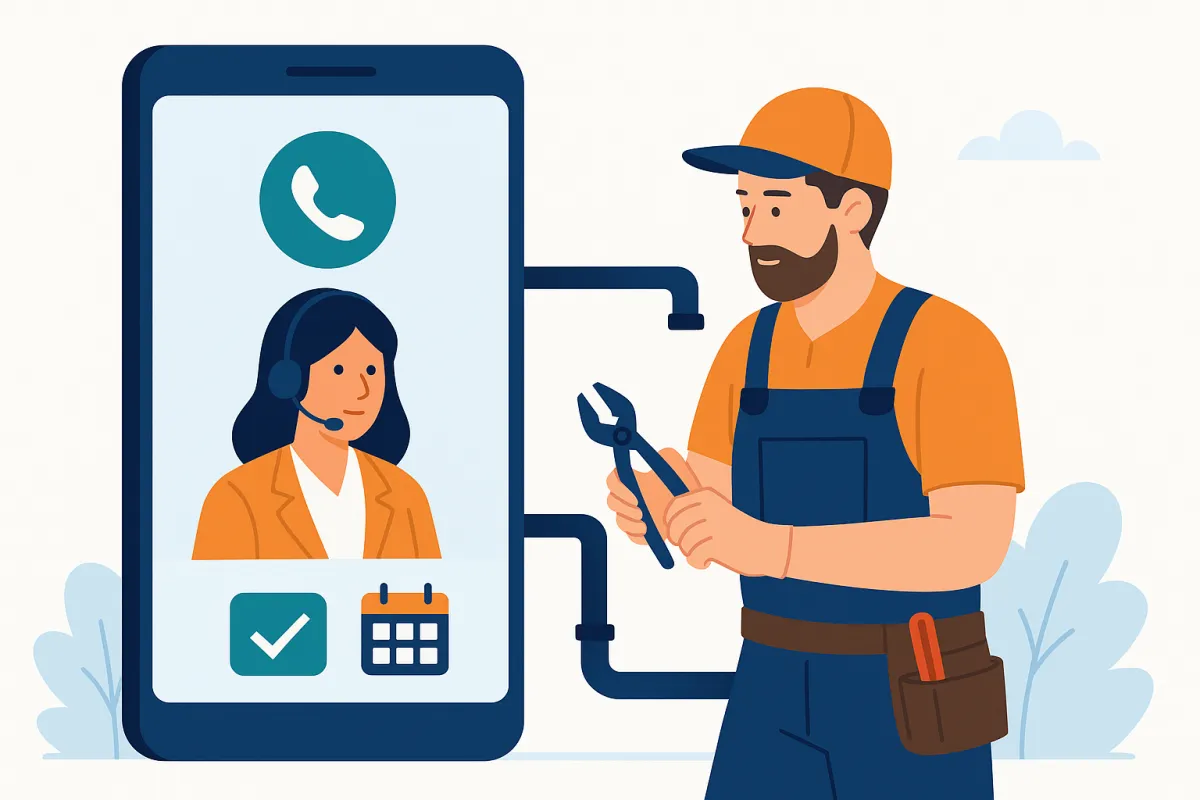
Virtual Assistant AI vs Phone Answering Service for Tradies
For Australian tradies, the choice between a traditional phone answering service and an AI receptionist using virtual assistant AI comes down to cost, availability, and ROI. A phone answering service gives you a human voice during business hours, but it’s limited and expensive. A virtual assistant AI receptionist works 24/7, books jobs instantly, and usually pays for itself with a single extra job per month.
Introduction: Why This Choice Matters
Most tradies know the pain of missed calls. You’re up a ladder, under a sink, or driving between jobs when the phone rings. By the time you call back, the customer has already booked with someone else. In today’s market, where customers expect instant responses, even one or two missed calls a week can drain thousands of dollars from your business.
That’s why many service business owners are weighing up two options:
A phone answering service with human receptionists.
An AI receptionist powered by virtual assistant AI technology.
Both solve the problem of missed calls, but in very different ways. This guide compares the two approaches in plain terms, with an Australian context.
Phone Answering Services: What You’re Really Paying For
Traditional phone answering services like OfficeHQ or local call centres employ human receptionists who take your calls, write down messages, and sometimes forward calls.
Availability and Coverage
Most phone answering services in Australia operate during standard business hours, with limited after-hours coverage. If you’re on the tools from 7am or working late, these services may not cover the times when customers actually call. Many services also charge extra for after-hours calls, public holidays, and weekends.
Cost Structure
Phone answering services typically charge a base fee plus a per-call or per-minute rate. For example, many providers charge from $30 per week plus call costs that range from $2.50–$4.00 per call. This may sound affordable, but the costs climb quickly if you’re getting 50–100 calls per month. That can easily reach $500–$1,000 per month for part-time coverage.
Professionalism and Personal Touch
The main selling point is a real human voice. Some customers feel more comfortable speaking to a person rather than automation. The downside is inconsistency. Staff may not know your trade-specific questions, and you’ll often just get messages instead of jobs booked.
Limitations for Tradies
If you use a job management platform like ServiceM8, Fergus, or Tradify, phone answering services rarely integrate. That means you still need to follow up manually, costing you more admin time.
If you’re weighing up different providers, it’s worth looking at a detailed breakdown of options on the market. Our guide to Best Phone Answering Service Australia: Complete Tradies Guide 2025 explores pricing, coverage, and which services actually suit small trade businesses.
AI Receptionists: How Virtual Assistant AI Works for Tradies
An AI receptionist is a voice agent trained to sound natural, answer FAQs, and book jobs directly into your calendar or job management system.
24/7 Coverage
The biggest win is availability. AI never clocks off. Whether a client calls at 7am, during smoko, or at 8pm, the call is answered instantly. No customer is left waiting for a callback.
Cost Model
In Australia, a typical AI receptionist costs about $2,500 upfront for setup and training, and $500 per month ongoing. That flat fee includes 24/7 coverage, booking integration, and call summaries. Even with higher call volumes, the costs don’t spike the way they do with phone answering services.
Integration With Trade Software
Unlike human call centres, AI receptionists integrate directly with job management tools like ServiceM8, Tradify, Fergus, and Buildxact. A client can call, ask for a quote, and get a booking confirmed without you touching your phone. This is where virtual assistant AI shines, because it doesn’t just take messages — it closes the loop with confirmed jobs.
Customer Experience
Modern AI voices sound almost indistinguishable from a human receptionist. Callers get instant answers and confirmation. For many tradies, the professionalism boost is just as valuable as the time savings.
Cost Breakdown: Virtual Assistant AI vs Phone Answering Service
Imagine a plumber in Sydney who gets 80 calls per month.
Phone Answering Service:
$30 per week = $120 per month80 calls x $3.00 = $240
= $360 per month, but only during business hours and often has to schedule his own jobs.
Virtual Assistant AI Receptionist:
$2,500 fully custom setup (once-off)
$500 per month ongoing
24/7 coverage, no per-call costs, jobs booked directly.
While the AI option requires a bigger upfront investment, the monthly fee is predictable and doesn’t spike with call volume. Over a year, the virtual assistant AI option is often cheaper once you factor in the value of booked jobs.
ROI Case Study: One Extra Job Pays for Itself
Let’s say the average job for an electrician is worth $400.
If the AI receptionist captures just two extra jobs per month that would have gone to voicemail, that’s $800 revenue.
The monthly cost is $500, so you’re already ahead by $300.
Over 12 months, that’s $3,600 extra profit, not counting the time saved on admin.
For bigger-ticket trades like plumbers or concreters, where jobs are often $1,000+, even a single recovered job per month more than pays for the system. Virtual assistant AI doesn’t just cover its costs — it actively grows revenue.
Pros and Cons of Each Approach
Phone Answering Services
Pros:
Human voice answering calls
No large upfront setup cost
Works well for very low call volumes
Cons:
Limited hours, expensive after-hours coverage
Costs spike with higher call volume
Messages only, rarely books jobs
No integration with trade software
AI Receptionists with Virtual Assistant AI
Pros:
24/7 availability, including weekends and holidays
Predictable monthly costs
Books jobs directly into your calendar or ServiceM8
Filters spam calls automatically
Pays for itself with one job per month
Cons:
Upfront setup fee
Some customers may still prefer a human voice
Requires initial training to match your business FAQs
For some business owners, the question isn’t just about AI versus human call centres. It’s about whether to go with a virtual receptionist service or a fully automated AI system. We’ve put together a comparison in AI Receptionist vs Virtual Receptionist: Which is Best for Australian Tradies? that breaks down the differences.
Frequently Asked Questions
Is virtual assistant AI hard to set up for my trade business?
No. Systems like Fully Booked handle the entire setup for you, including scripts, FAQs, and booking integration so it sounds natural and human like.
What if my clients prefer speaking to me directly?
The AI receptionist can transfer important calls to your mobile, so you’re still in control.
Will clients know they’re speaking to AI?
Most won’t. Modern virtual assistant AI voices are natural and professional. Many callers assume they’re speaking with a receptionist but we always disclose up front they're speaking to AI.
What if my call volume is very low?
If you’re only getting 5–10 calls per month, a phone answering service may be cheaper. But for 50+ calls per month, virtual assistant AI delivers better ROI.
Key Facts: Quick Takeaways
Phone answering services in Australia start from $30/week plus $2.50–$4.00 per call.
Virtual assistant AI receptionists cost around $2,500 setup and $500/month ongoing.
For tradies, even one missed job per month can equal $400–$1,000 in lost revenue.
Virtual assistant AI integrates with tools like ServiceM8 and Tradify for real-time bookings.
Predictable monthly costs make AI receptionists more scalable as call volumes grow.
Conclusion: Which Should You Choose?
If you’re a sole operator with very few calls, a phone answering service may be a simple, low-cost option. But for most Australian tradies handling 50+ calls per month, a virtual assistant AI receptionist delivers stronger ROI, better customer experience, and peace of mind.
Every missed call is a missed job. With a virtual assistant AI receptionist, you don’t just save time — you protect revenue and present your business as professional and responsive, even when you’re up a ladder or on the tools.
Next step: See how an AI receptionist in Australia works in action and book a demo for your own business.

